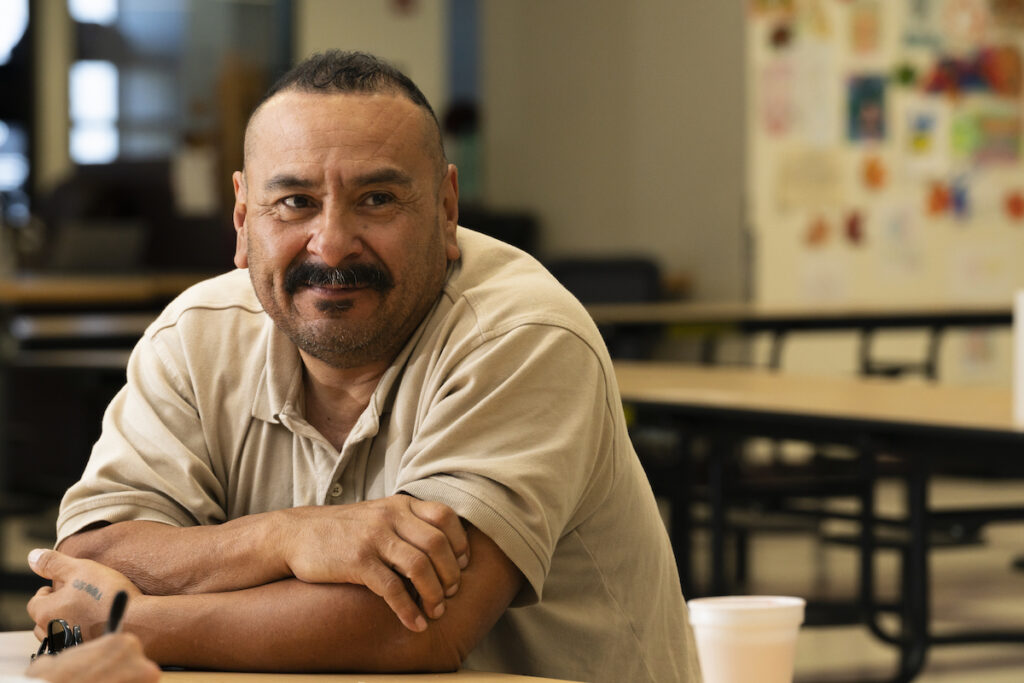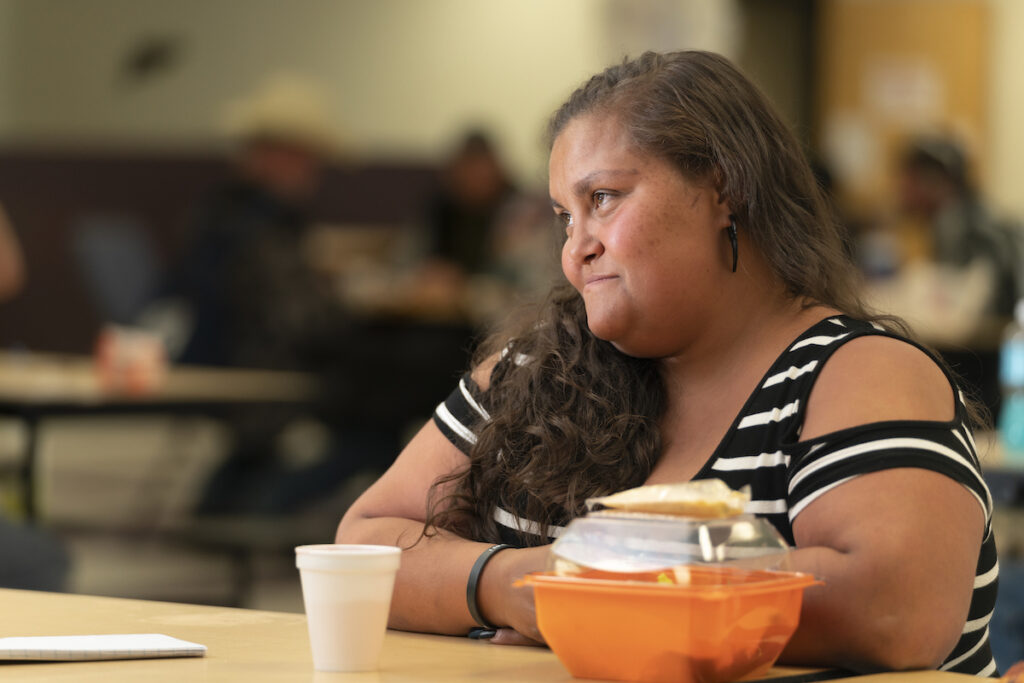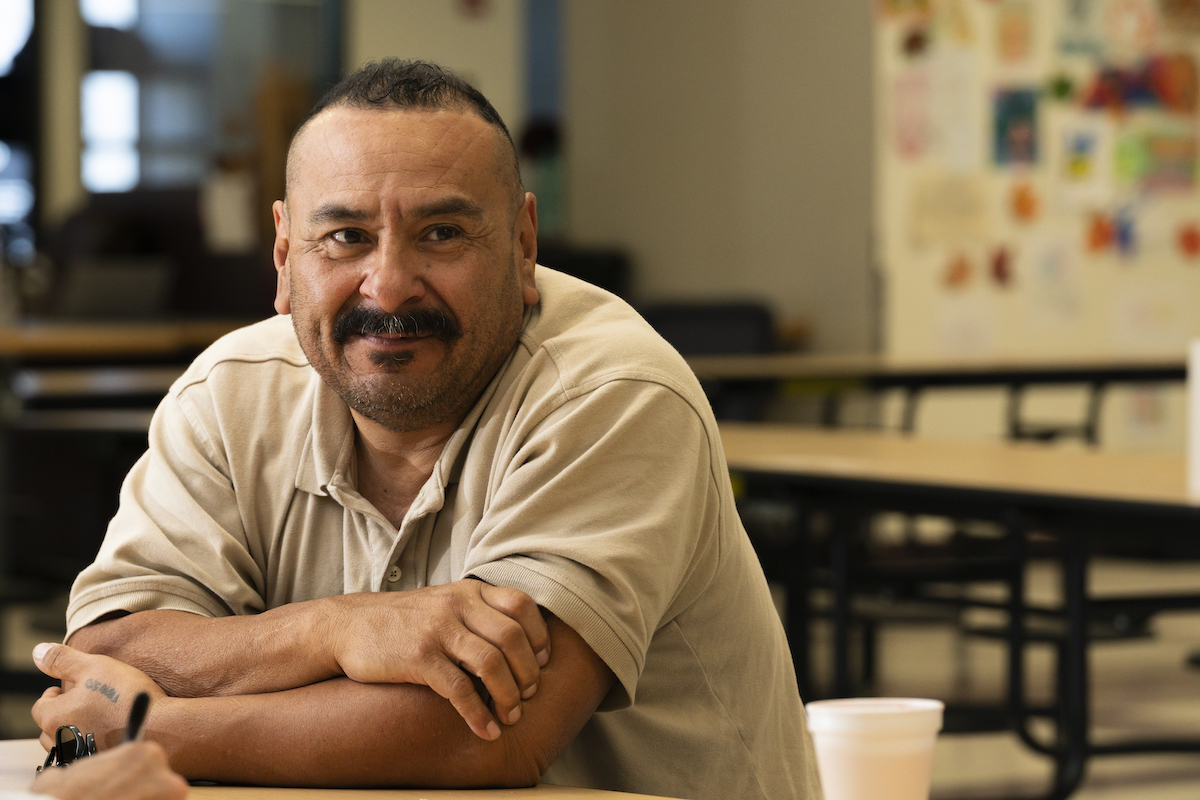
By Jeff Grant, The Catholic Sun
PHOENIX — Fifteen months ago, Frank Frausto was living in a park in central Phoenix.
“I had one sleeping bag. I would leave my stuff at a friend’s house. I would ‘shower’ in the park restrooms, then I would go to St. Vincent de Paul [downtown campus] for my breakfast and lunch,” he recalled.
The depths to which the 58-year-old’s life had plummeted were the result of drug use. Addiction was sapping his income as a construction worker, he lost his vehicle and lacked the funds for repairs or a replacement, then he lost his rental room.
“I chose to do drugs. I lived the drug life. Every day, I was doing meth,” he said.
One of 12 siblings, Frausto nonetheless had nowhere to turn, except for one sister, who told him unless he got off drugs, she would not house him with her family.
“She didn’t want my nephews to see me on drugs,” he explained.
Enter St. Vincent de Paul.
On May 1, 2022, he learned the Catholic charity organization was launching a new provisional housing shelter near the park at 28th and Washington streets. He began staying there, found a new job, and quit drugs for good.
“One day, I just decided not to do it no more. I relapsed after my first paycheck, [and] I felt guilty… like I didn’t deserve to be here. My conscience — that’s what made me stop. I wanted to prove to my sister I could do it.
“I’m getting my life back together again.”
Candice Barron, 28, had a difficult life from an early age.
“I grew up in a broken family. My parents divorced when I was little. I didn’t meet my sister until I was 18,” she said.
A self-described “hard child to deal with,” Barron said she had a lot of anger. By age 15, she began living on and off the streets and started using drugs.
“I preferred being on the streets than at home because my dad did nothing to stop my stepmom from mistreating me. I wasn’t allowed to hang with friends, have slumber parties or none of that. I didn’t have much of a childhood,” she said.
Eventually, she started using heroin and meth.
She also found a place to reset her life at St. Vincent de Paul’s provisional housing shelter and is working to move into her own place by July.
“They have given me a lot of chances. I’ve had a lot of anxiety attacks. They’ve worked with me a lot. There are a couple of staff members who will sit there and talk me down, through my attacks,” she said.
Frausto and Barron are but two of the more than 800 residents that the shelter – St. Vincent de Paul’s newest – has helped in its first year of operation.


A CHALLENGE
The Society of St. Vincent de Paul is a worldwide charitable organization that began in 1833 in Paris as a response by a 20-year-old university law student to a challenge raised by colleagues in a debate. Frederic Ozanam was asked to show what he and his fellow Catholic students were personally doing to help the city’s poor. Within weeks, Ozanam and six colleagues were working together, paying out of their own pockets and with contributions from friends, to aid the less fortunate. They would visit the poor in their homes, providing aid and assistance.
In a few years, the “conference of charity” grew to hundreds of members across 15 other French cities and towns. The program’s model is still followed today by the organization’s Phoenix chapter, which began in 1949 with conferences at St. Agnes, St. Francis Xavier, and St. Mary’s churches three years after five young Catholic men in the Valley first met to discuss starting a chapter here.
The society has been operating a dining room and heat-relief shelter at its downtown Phoenix campus as well as a 60-bed traditional dormitory-style housing site for older adults, veterans, and disabled adults, also in Phoenix.
Then, early last year, the chapter’s homeless outreach expanded.
DRAMATIC TREND
Like other major U.S. metropolitan areas, Phoenix has seen a dramatic rise in homelessness over the past 5-7 years. An annual report by the Maricopa Association of Governments, a regional planning and policy agency, stated unsheltered homelessness in the Maricopa County region increased by 92 percent between 2018 and 2022. The majority of that population is in central Phoenix.
The city and county have been working on several fronts to address the issue. Familiar with St. Vincent de Paul’s mission and its reputation for helping people eventually find their own residence, Phoenix officials reached out.
“The city approached St. Vincent de Paul for some creative options for housing the homeless, creating an overnight space for the heat-relief period,” recalled Washington Street Shelter Program Manager Jennifer Morgan. “They said, ‘We need a 200-person space.’”
The agency was willing but had no site.
“The city found the building, formerly an Arizona Department of Transportation building and Motor Vehicles Division field office [at Washington and 28th streets]. We had to do some renovations,” Morgan said.
According to the city’s Human Services Department, Phoenix and Maricopa County utilized nearly $5 million in American Rescue Plan Act funds — the federal government’s multi-pronged relief effort aimed at the continued impact of the COVID-19 pandemic. The city contributed $2.6 million, and the county more than $2 million.
“With homelessness increasing across the region, we need to address both the immediate and long-term needs of individuals and communities. This partnership achieves that,” Maricopa County Board of Supervisors Chairman Bill Gates, District 3, was quoted as saying in a city news release announcing the project last year.
“First, it provides shelter that will literally save lives during the intense summer heat. Second, it connects people experiencing homelessness to resources that can help them find jobs and permanent housing,” Gates stated.
‘NO WAKING PEOPLE UP’
A second phase of renovations is continuing, which Morgan said will add restrooms and showers. Until now, showers have been provided through trailers loaned by the state. During the March 25 visit, work equipment and new plumbing were visible throughout the restroom area.
The two-story structure, which opened May 13, 2022, provides year-round transitional housing for up to 200 individuals at a time. Residents are allowed to house their pets in a separate area.
“There is no waking people up early in the morning, so they can wait in line to see if they can get a bed for the next night,” Morgan explained. “That location is their home.”
The goal is to help residents get their lives together and obtain their own residence.
As of January 31, the shelter had served 829 individuals, with 467 leaving for permanent housing.
While at the shelter, residents can do community work. Under St. Vincent de Paul’s Work Opportunities Program, the organization identifies areas needing beautification or cleanup, and sends groups of shelter residents out regularly. Morgan said the program has been particularly effective helping local seniors.
“We were able to help neighbors address things they were unable to on their own.” *****
Morgan said the agency tries to approach each person individually rather than view them as a number or part of trend data.
“We determine what barriers they’re facing and address those, making sure they move forward as part of the community rather than just participating in just another program,” she said.
That can mean helping a resident obtain a driver’s license, government identification, or a birth certificate, help with financial-aid paperwork, rides to jobs, clothing for work, and more.
“They’ve given me bus passes; rides, if we need to go to the hospital,” said Barron.
“The people who work here are awesome. Whatever you need, they’ll go out of their way to help you,” said Frausto.
‘WE ARE SERVING CHRIST’
That service doesn’t stop when a resident finds permanent housing.
St. Vincent de Paul assigns volunteers to take the individual on a shopping trip, using vouchers at one of the agency’s thrift stores or participating retailers.
“We help them be a little more sustainable. If they don’t have a couch, sheets, pillows, towels, kitchen utensils, lamps… we help set up a home for them, really making [it] their own,” said Irma Leyendecker, director of mission advancement for St. Vincent De Paul’s Phoenix chapter.
“We learn from the shelter when someone is moving out. We’ll outreach them, help them make a shopping list. We’ll start with necessities, but we’ll also help them find pictures, art pieces, artificial plants, flowers. We’ll schedule delivery. They get very excited,” Leyendecker said.
The support doesn’t end there, either.
Working with local St. Vincent de Paul conferences at churches, the agency links individuals in permanent housing to volunteers and resources, so they don’t fall through the cracks, find themselves alone, or feel isolated.
“We try to create a sense of community for them,” Leyendecker explained.
Volunteers known as “Vincentians,” a longtime component of the worldwide agency, make home visits, deliver food, assess needs, and pray with individuals.
“The person doesn’t have to be Catholic or attending church,” Leyendecker said.
Donations of goods, financial support and volunteers fuel the effort.
“We couldn’t do what we do without our great donors. That really keeps our program bountiful. Whether it’s with the shelter, a resource center, or visiting. We have so many programs. And it takes a lot to run things, especially now with [high] gas [prices]. There are so many ways for people to get engaged,” Leyendecker said.
“We try to help people understand those who come to us in need are really not all that different than we are. When you look at them and peel away that (expression) of struggle, you can see we are all in the image of Christ.
“We tell our volunteers, look them in the eye, use their name. They then see themselves as a person. We are serving Christ.
“Lives are being saved every day because of the work we are doing.”






